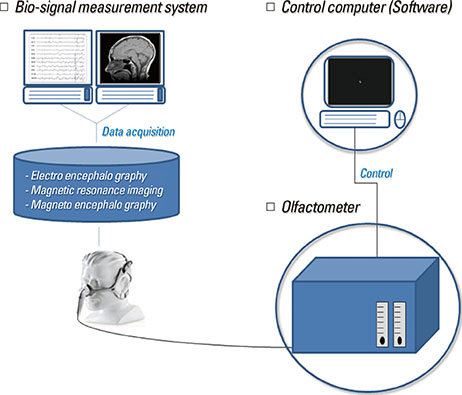Hanyang Med Rev.
2014 Aug;34(3):120-124. 10.7599/hmr.2014.34.3.120.
The Current Status of Evaluation Technologies for the Function of Human Olfaction
- Affiliations
-
- 1Department of Biomedical Engineering, Hanyang University, Seoul, Korea. iykim@hanyang.ac.kr
- KMID: 2284352
- DOI: http://doi.org/10.7599/hmr.2014.34.3.120
Abstract
- The sense of smell is one of the essential tools for all living things to survive. With recent increase in diseases associated with olfactory dysfunction, the evaluation of olfactory function aims to shed light on the understanding and assessment of the human olfactory system. The methods for assessing the olfactory function are largely divided into electrophysiological and psychophysical methods. The psychophysical inspections such as University of Pennsylvania Smell Identification Test (UPSIT), The Sniffin' Stick, and T & T Olfactometer are methods mostly based on questionnaires or simple apparatus. Those have been generally used in clinical and research field due to their relatively short examination time and low cost. The electrophysiological tests evaluate olfactory function based on objective measurements like biosignals and medical imaging. Compared to the psychophysical methods, they comparably have higher reliability and are possible to assess more specific diagnosis. However, the system configuration seems to be more complicated. In this paper, we review the overall evaluation methods of olfactory functions and suggest complementary points to improve conventional technologies.
Keyword
MeSH Terms
Figure
Cited by 1 articles
-
Unravel the Secret of Olfaction
Seok Hyun Cho
Hanyang Med Rev. 2014;34(3):97-99. doi: 10.7599/hmr.2014.34.3.97.
Reference
-
1. Galizia CG, Lledo PM. Olfaction. In : Galizia CG, Lledo PM, editors. Neurosciences - from molecule to behavior: a university textbook. 2nd ed. Berlin: Springers;2013. p. 253–283.2. Stevenson RJ. An initial evaluation of the functions of human olfaction. Chem Senses. 2010; 35:3–20.
Article3. Korea. S. National Helath Insurance Service: 2004-2011 Frequent Sickness. 2011.4. Apter AJ, Mott AE, Frank ME, Clive JM. Allergic rhinitis and olfactory loss. Ann Allergy Asthma Immunol. 1995; 75:311–316.5. Morgan CD, Murphy C. Olfactory event-related potentials in Alzheimer's disease. J Int Neuropsychol Soc. 2002; 8:753–763.
Article6. Doty RL. Olfactory dysfunction in Parkinson disease. Nat Rev Neurol. 2012; 8:329–339.
Article7. Doty RL, Li C, Mannon LJ, Yousem DM. Olfactory dysfunction in multiple sclerosis: relation to longitudinal changes in plaque numbers in central olfactory structures. Neurology. 1999; 53:880–882.
Article8. Hummel T, Sekinger B, Wolf SR, Pauli E, Kobal G. 'Sniffin' sticks': olfactory performance assessed by the combined testing of odor identification, odor discrimination and olfactory threshold. Chem Senses. 1997; 22:39–52.
Article9. Takagi SF. A standardized olfactometer in Japan. A review over ten years. Ann N Y Acad Sci. 1987; 510:113–118.10. Hummel T, Knecht M, Kobal G. Peripherally obtained electrophysiological responses to olfactory stimulation in man: electro-olfactograms exhibit a smaller degree of desensitization compared with subjective intensity estimates. Brain Res. 1996; 717:160–164.
Article11. Hong SC, Yoo YS, Kim ES, Kim SC, Park SH, Kim JK, et al. Development of KVSS Test (korean version of sniffin' sticks test). Korean J Otolaryngol-Head Neck Surg. 1999; 42:855–860.12. Cho JH, Jeong YS, Lee YJ, Hong SC, Yoon JH, Kim JK. The Korean version of the Sniffin' stick (KVSS) test and its validity in comparison with the cross-cultural smell identification test (CC-SIT). Auris Nasus Larynx. 2009; 36:280–286.
Article13. Yucepur C, Ozucer B, Degirmenci N, Yildirim Y, Veyseller B, Ozturan O. University of Pennsylvania smell identification test: application to Turkish population. Kulak Burun Bogaz Ihtis Derg. 2012; 22:77–80.
Article14. Doty RL, Marcus A, Lee WW. Development of the 12-item Cross-Cultural Smell Identification Test (CC-SIT). Laryngoscope. 1996; 106:353–356.
Article15. Cain WS, Gent JF, Goodspeed RB, Leonard G. Evaluation of olfactory dysfunction in the Connecticut Chemosensory Clinical Research Center. Laryngoscope. 1988; 98:83–88.
Article16. Lorig TS, Elmes DG, Zald DH, Pardo JV. A computer-controlled olfactometer for fMRI and electrophysiological studies of olfaction. Behav Res Methods Instrum Comput. 1999; 31:370–375.
Article17. Scott JW, Scott-Johnson PE. The electroolfactogram: a review of its history and uses. Microsc Res Tech. 2002; 58:152–160.
Article18. Geisler MW, Murphy C. Event-related brain potentials to attended and ignored olfactory and trigeminal stimuli. Int J Psychophysiol. 2000; 37:309–315.
Article19. Thesen T, Murphy C. Age-related changes in olfactory processing detected with olfactory event-related brain potentials using velopharyngeal closure and natural breathing. Int J Psychophysiol. 2001; 40:119–127.
Article20. Lundstrom JN, Seven S, Olsson MJ, Schaal B, Hummel T. Olfactory event-related potentials reflect individual differences in odor valence perception. Chem Senses. 2006; 31:705–711.
Article21. Kettenmann B, Hummel C, Stefan H, Kobal G. Multiple olfactory activity in the human neocortex identified by magnetic source imaging. Chem Senses. 1997; 22:493–502.
Article22. Levy LM, Henkin RI, Hutter A, Lin CS, Martins D, Schellinger D. Functional MRI of human olfaction. J Comput Assist Tomogr. 1997; 21:849–856.
Article23. Popp R, Sommer M, Muller J, Hajak G. Olfactometry in fMRI studies: odor presentation using nasal continuous positive airway pressure. Acta Neurobiol Exp (Wars). 2004; 64:171–176.24. Wetter S, Polich J, Murphy C. Olfactory, auditory, and visual ERPs from single trials: no evidence for habituation. Int J Psychophysiol. 2004; 54:263–272.
Article25. Kassab A, Schaub F, Vent J, Huttenbrink KB, Damm M. Effects of short inter-stimulus intervals on olfactory and trigeminal event-related potentials. Acta Otolaryngol. 2009; 129:1250–1256.
Article26. Hummel T, Livermore A. Intranasal chemosensory function of the trigeminal nerve and aspects of its relation to olfaction. Int Arch Occup Environ Health. 2002; 75:305–313.
Article




